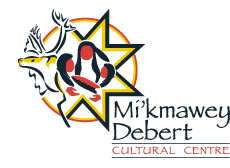Mi'kmawey Debert Cultural Centre Trivia
Congratulations - you have completed Mi'kmawey Debert Cultural Centre Trivia.
You scored %%SCORE%% out of %%TOTAL%%.
Your performance has been rated as %%RATING%%
Your answers are highlighted below.
Question 1 |
Mi’kmaw people were buried with clothes, food, and other items so:
They could bring gifts to the Ghost World | |
The item’s spirits could join them | |
The person’s belongings are not used by others |
Question 1 Explanation:
Men and women would be buried with everything they might need, including unfinished projects, so they would be well prepared in the Ghost World. This practice is continued by some Mi’kmaq today.
Question 2 |
During the colonial period, Mi’kmaw men and women wore these items of clothing as special to Mi’kmaw culture:
Amauti and mukluks | |
Button blankets | |
Embellished waistcoats, feathered headdresses and peaked caps |
Question 2 Explanation:
Men’s and women’s clothing were richly embellished with beads and embroidery. As with many other eastern First Nations, traditionally, headdresses had feathers that stood up straight at the front of the headdress. The women’s peaked cap is unique to Mi’kmaw culture.
Question 3 |
A “mikjikj” always carries her:
House | |
Notebook | |
Supper |
Question 3 Explanation:
Turtles are always at home.
Question 4 |
The Mi’kmaw game of waltes is a set of playing pieces, shaken in a bowl made of:
Stone | |
Antler | |
Wood |
Question 4 Explanation:
The bowl was hollowed out of a large burl, or knot, which grew on the trunks of large trees.
Question 5 |
In 1973, which community became the 12th Mi’kmaw band in Nova Scotia?
Membertou | |
Pictou Landing | |
Acadia |
Question 5 Explanation:
With more than 1,000 members, the Acadia First Nation is comprised of five reserves, which are located in various locations across southwest Nova Scotia.
Question 6 |
Mi’kmaw language is part of which language family?
Algonquian | |
Iroquois | |
Salishan |
Question 6 Explanation:
The Algonquian language family is the largest in North America and includes numerous indigenous languages stretching from the easternmost shores of Mi’kma’ki to the territories of the Blackfoot and Plains Cree in Alberta to as far south as the state of South Carolina in the United States.
Within the Algoniquian language family there are more than 40 languages.
Question 7 |
Ancient Mi’kmaw beliefs honour how many Creator figures?
One | |
Three | |
Seven |
Question 7 Explanation:
There is one Creator. Legends tell of many beings having various degrees of spiritual powers, but only one supreme Creator figure.
Question 8 |
Eskasoni’s Lee Cremo gained international acclaim for playing which instrument?
Fiddle | |
Drums | |
Tin flute |
Question 8 Explanation:
The fiddle. Lee Cremo won “Best Bow are in the World”, at the World Fiddle Championship in Nashville, Tennessee.
Question 9 |
In the early and mid 20th Century the Indian Affairs developed introduced the Centralization policy for the Mi’kmaq in Nova Scotia. The policy included efforts to:
Deliver services to Indians from urban centers | |
Provide services from one central office | |
Move the Mi’kmaw population to two reserves |
Question 9 Explanation:
The aim of Centralization was to relocate the Mi’kmaq to two reserves, Eskasoni and Shubenacadie. Promises were made of new houses and work that were not kept.
Question 10 |
In 1841 Grand Chief John Denny Jr. was born. Denny was to become the last hereditary Mi’kmaw Grand Chief to:
Meet officials in traditional clothing | |
Allow squatters to buy Mi’kmaq land | |
Acquire his title by succeeding his father |
Question 10 Explanation:
Mi’kmaw chiefs, whether governing under the provisions in the Indian Act or participating in the Grand Council of Mi’kmaw Chiefs, have since been elected to represent their people.
Once you are finished, click the button below. Any items you have not completed will be marked incorrect.
There are 10 questions to complete.
|
List |

 sharing our stories
sharing our stories